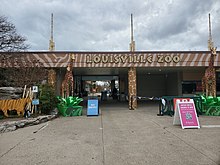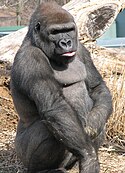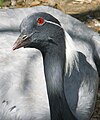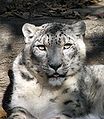Louisville Zoo
 Zoo Entrance | |
| Date opened | May 1, 1969 |
|---|---|
| Location | Louisville, Kentucky, United States |
| Coordinates | 38°12′19″N 85°42′19″W / 38.20528°N 85.70528°WCoordinates: 38°12′19″N 85°42′19″W / 38.20528°N 85.70528°W |
| Land area | 134 acres (54 ha) |
| No. of animals | 1,700 |
| Annual visitors | 900,000+ |
| Memberships | AZA,[1] AAM[2] |
| Major exhibits | Gorilla Forest, Islands |
| Website | www |
The Louisville Zoological Gardens, commonly known as the Louisville Zoo, is a 134-acre (54 ha) zoo in Louisville, Kentucky, situated in the city's Poplar Level neighborhood. Founded in 1969, the "State Zoo of Kentucky" currently exhibits over 1,700 animals in naturalistic and mixed animal settings representing both geographical areas and biomes or habitats.
The Louisville Zoo is accredited by the Association of Zoos and Aquariums and the American Alliance of Museums. During the 2006–07 season, the zoo set an all-time yearly attendance record with 810,546 visitors.[3]
The Louisville Zoo's mission is "To better the bond between the people and our planet".
History[]
This section needs expansion. You can help by . (December 2009) |
The Louisville Zoo opened on May 1, 1969, with 250 animals on exhibit.[4] The zoo was built on land acquired by the City of Louisville in the 1960s from the estate of Ben Collins. Much of the initial funding was donated by local philanthropist James Graham Brown.
Opening Day in 1969 mostly had exhibits with four-legged animals such as elephants and giraffes. The zoo also offered a train to take zoo visitors past several exhibits; the attraction operates to this day. Opening Day had some criticism from the general public as a lack of shade was evident throughout the zoo. Over time, tree growth has reduced the problem.
In 1997, a fully restored Philadelphia Toboggan Company (PTC #49) carousel was added as an attraction.[5] In May 2007, Glacier Run Splash Park, a children's water playground with 42 water-spray features, opened at the zoo.[6] The splash park was the first phase of the Glacier Run area to open, which features polar bears exhibits modeled after the town of Churchill, Manitoba, Canada.[7]
Exhibits[]

The Louisville Zoo has eight zones of exhibits: The Islands, Africa, Glacier Run, Australia, South America, HerpAquarium, Gorilla world, and the cats of the americas
Gorilla Forest[]
The zoo was awarded the 2003 Association of Zoos and Aquariums Exhibit Award for its 4-acre (16,000 m2) exhibit "Gorilla Forest".[8] The exhibit currently houses 11 western lowland gorillas, and two pygmy hippopotamuses.Inside the circular Gorilla Sanctuary, visitors are separated only by glass and can get nose-to-nose with the gorillas. Several different outdoor vantage points are available from which to see the gorillas playing and relaxing.[9]
Herpaquarium[]

The HerpAquarium features 17 Vampire bats , and over 100 species of reptiles, amphibians, and fish, from around the world. A notable resident of the HerpAquarium is a 6-foot-long (1.8 m) rare albino American alligator named King Louie. He is named after King Louis XVI of France, after whom the city of Louisville is also named.[10] Louie was hatched at the St. Augustine Alligator Farm Zoological Park. The Louisville Zoo currently houses a group of critically endangered Panamanian golden frogs. The zoo is working to preserve this species of frog from extinction. Their numbers have declined in the wild partly due to the chytrid fungus and habitat destruction. On March 31, 2006, the zoo added a bachelor group of seven vampire bats obtained from the Philadelphia Zoo, and another 10 from the Sedgwick County Zoo were added to the group in late May 2006. Eventually, the exhibit will house around 40 bats. The exhibit is designed to look like an old mine shaft. [11]
Islands[]

The zoo has a distinctive zoological exhibit called "Islands", which is the first exhibit in the world that uses a system of rotating a variety of animals into one exhibit. This way, the animals can explore different habitats throughout the day, as they would in the wild. This helps to give the animals needed stimulation and heightens their awareness. Moreover, the exhibit is the first to have natural predator and prey in the same space. It has three outdoor exhibit areas and one indoor area. All animals in this exhibit are endangered or threatened species. The animals on display here change from day to day so that visitors can have a new and different experience with each visit to the zoo. The animals that can be seen in this exhibit include the Sumatran tiger, orangutan, siamang, babirusa, and Malayan tapir.[12]The zoo is home to four orangutans, two males named Teak and Segundo (aka Gunny) and two females named Amber and Bella. Amber and Teak are half-siblings sharing the same father and are hybrid orangutans, while Gunny and Bella are purebred Sumatran orangutans and are under breeding recommendation, though there has yet to be any successful breeding between them.The Islands Pavilion is an indoor area that houses many species of birds, including the white-throated ground-dove. The zoo was the first zoo in the world to hatch this rare dove in captivity. The first hatchling was born on October 17, 2006, and a second followed on December 1, 2006.[13] Some of the other bird species included in the Islands Pavilion are the Mariana fruit dove, Madagascar fody, and the black-footed penguin. The pavilion also houses the Rodrigues fruit bat, Cuban crocodile, and Komodo dragon.

Wallaroo Walkabout[]
The new Wallaroo Walkabout that opened in 2007 lets guests walk directly through the exhibit, which is home to the wallaroo and red-necked wallaby, as well as some Australian birds including the kookaburra, blue-faced honeyeater, emu, and tawny frogmouth. Visitors are able to interact with the wallaroos and wallabies if they stay on the walkway. Then after the wallabies and wallaroos, guests can go into the Lorikeet Landing, which is an Australian exhibit that is a walkthrough aviary filled with several brightly colored birds known as lorikeets. Visitors can feed nectar to the birds right out of their hands. The lorikeet species at the Louisville Zoo are the black-winged lory, green-naped lorikeet, perfect lorikeet, red lory, and Swainson's lorikeet.[14]
Glacier Run[]
Finished in early 2011, this 4.3-acre (1.7 ha) outdoor exhibit is based on the theme of an old gold-mining town bordered by a glacier. It features polar bears, harbor seals, gray seals California sea lions, grizzly bears, snowy owls, Steller's sea eagles, Mandarin ducks, the Red-breasted goose, and Azure-winged magpies then outside the gold mine town are 3 exhibits for snow leopards, Amur tigers, and Red-crowned Cranes. The exhibit also has a splash park for children that opened in 2007, and was the first part of this $25 million exhibit to open.[15][16] The exhibit also includes classrooms, party rooms available for rental, viewing areas above and below water, and a 200-seat outdoor auditorium for watching animal training demonstrations.
Africa[]
This region of the zoo is based on the African Serengeti. Animals featured here include the lion, Arabian camel, Southern white rhinoceros, Warthog, Addax, Meerkat, Naked mole-rat, Hartmann's mountain zebra, Masai giraffe, Gray crowned cranes, Eastern bongo, Rock hyrax, and a new colobus monkey exhibit that opened in 2019. The zoo is one of the few zoos to exhibit African and Asian elephants together in the same habitat. The zoo is home to an Asian elephant named Punch, who is 51 years old, and an African bush elephant named Mikki, who is 36 years old and her son named Fitz, who is now 2 years old.
Cats of the Americas[]
This part of the zoo is right next to the south America region, and it has all rescued animals that can't be returned to the wild. The animals include Canada lynxes, Bald eagles, and Cougars.
South America[]
This region of the zoo has animals from the Andes grasslands and amazon rainforest of south America along with a botanical garden area, and the animals in that region include Chilean flamingos, Maned wolves, Two-toed sloths, Jaguars, Hyacinth macaws, and guanacos.
Notable individual animals[]
- Mojo, a patas monkey previously owned by NASCAR driver Tony Stewart, was given to the zoo on August 24, 2007, when he became too aggressive to keep as a pet.[17]
- Scotty, an African elephant born on March 18, 2007, was the first elephant born in Kentucky. Scotty died on May 12, 2010, when he was only three years old, due to severe gastric and intestinal problems.[18][19][20]
- The Louisville Zoo has hand-raised three baby siamangs—Sungai (from the San Francisco Zoo), Zoli (born at the Louisville Zoo), and Zain (from the Albuquerque Biological Park) after Zoli's parents died of E. coli sepsis and the other two were brought in as companions[21]—and is thought to be the only Zoo to ever hand raise three baby siamangs this young.[22]
- The zoo is also home to several black-footed ferrets, and participates in the black-footed ferret breeding program. The ferrets are one of the most endangered species in North America.[citation needed]
- Bakari (whose name is Swahili for hopeful) the Masai giraffe was born on February 17, 2009, with angular limb deformity, and had periosteal stripping[clarification needed] performed on his leg. He is believed to be the first giraffe to undergo this procedure.[23]
- In June 2013, the Louisville Zoo organized a contest to name the first zebra foal to be born at the zoo in 13 years.[24] The foal was ultimately named Ziva, after the fictional character Ziva David from the television series NCIS.[25][26]
- On October 23, 2014, the zoo announced that their 11-year-old reticulated python, Thelma, had produced six healthy baby snakes in 2012 without any prior interaction with a male. She is the first known individual of her species (the world's largest species of snake) to have done so in captivity.[27] It had initially been thought that the offspring were produced from long-stored sperm, until genetic testing showed that the neonates were "half clones" – i.e., she was their only genetic parent.[27]
Events[]
- The Louisville Zoo offers multiple chances to enjoy the zoo after normal operating hours. One of the most popular after-hours events is the "World's Largest Halloween Party". This event is held on October 31 yearly and is Halloween themed. Another popular event is "Brew at the Zoo", which is an event that brings together local restaurants and craft beer vendors. Live entertainment is also provided. This event is typically in August and regularly sells out.
Activities[]
During October, the zoo hosts the "World's Largest Halloween Party", one of the largest Halloween parties in the United States.
The zoo has a booth called "Handimals" located by the entrance where kids can make an animal out of their hand prints.
Often when an animal is born in the zoo, the zoo holds a contest where participants send in ideas for names.
Incidents[]

On July 1, 1994, a man was picked up and dropped several times by an African elephant named Kenya. As a result of the man's injuries, his spleen and part of his pancreas were removed. The elephant had just finished giving rides to zoo visitors and was being led away when she wandered off and picked up the man. Zoo officials said that the elephant, who was normally considered calm and docile, was just "horsing around".[28]
On June 1, 2009, the zoo train derailed. Three open-air cars and the engine went off the tracks and caused the passenger car to topple over, due to excessive speed and operator inexperience.[29] The incident injured 22 people. An Indiana family that was on the train when the accident happened has sued the Louisville Zoo. Amy and Darren Bamforth filed the lawsuit on June 10, 2009. Another family in Louisville who was on the train, also filed a suit. They sought unspecified monetary damages as well as a court order preventing the zoo from altering or destroying the train while the lawsuit proceeds. A spokesman for the zoo declined to comment. The zoo train was closed for four years. On July 2, 2013, the zoo train reopened to the public after buying new trains and investing in expanded training procedures. All legal actions regarding the incident were concluded as of October, 2015.[29]
Gallery[]

Addax

African lion

Demoiselle crane

African pygmy falcon

Asian elephant

Mhorr gazelle

Jaguar

Peacock

Southern white rhinoceros
See also[]
- List of attractions and events in the Louisville metropolitan area
- List of parks in the Louisville metropolitan area
- Senning's Park, Louisville's first zoo
References[]
- ^ "Currently Accredited Zoos and Aquariums". aza.org. AZA. Retrieved June 24, 2011.
- ^ "List of Accredited Museums" (PDF). aam-us.org. AAM. Retrieved June 24, 2011.
- ^ "Zoo sets attendance record". The Courier-Journal. July 9, 2007. Archived from the original on July 29, 2012. Retrieved July 9, 2007.
- ^ "1969". louisvillezoo.org. Louisville Zoo. Retrieved October 27, 2020.
- ^ "Louisville Zoo, Louisville, KY". National Carousel Association. Retrieved November 8, 2018.
- ^ Karman, John (September 6, 2007). "Beating the heat: Zoo's baby animals, new Splash Park drive attendance up in spite of heat wave". American City Business Journals. Advance Publications. Retrieved October 27, 2020.
- ^ Nash, Martin (April 13, 2011). "Polar bears move in at Louisville Zoo". Leisure Management. Leisure Management. Retrieved October 28, 2020.
- ^ "The Louisville Zoo Wins Coveted AZA Exhibit Award". Archived from the original on February 11, 2006. Retrieved September 9, 2006.
- ^ "Inside Gorilla Forest". Louisville Zoo (official website). Archived from the original on January 6, 2009. Retrieved February 4, 2009.
- ^ "Rare white alligator". Louisville Zoo (official website). Archived from the original on October 23, 2007. Retrieved February 4, 2009.
- ^ "Furry little blood suckers now at Zoo". Louisville Zoo (official website). Archived from the original on July 20, 2011. Retrieved February 4, 2009.
- ^ "Islands Rotational Exhibit". Louisville Zoo (official website). Archived from the original on February 26, 2009. Retrieved February 4, 2009.
- ^ "Media Release, Worlds first captive hatching". Retrieved February 4, 2009.
- ^ "Lorikeet Landing". Louisville Zoo (official website). Archived from the original on February 25, 2009. Retrieved February 4, 2009.
- ^ "City News". louisvilleky.gov.
- ^ "Glacier Run". Archived from the original on October 16, 2012.
- ^ "Tony Stewart's former pet monkey, Mojo, now resides at the Louisville Zoo". Archived from the original on June 30, 2008.
- ^ "Baby Elephant, First to be born in Louisville". Louisville Zoo (official website). Archived from the original on May 30, 2008. Retrieved September 15, 2008.
- ^ "Baby elephant Scotty passes away". Fox 41. Archived from the original on July 30, 2012.
- ^ "Deceased elephants at Louisville Zoo in United States". elephant.se. Koehl D, Elephant Encyclopedia. Retrieved July 31, 2011.
- ^ "Siamang death investigation complete". Louisville Zoo (official website). February 28, 2008. Archived from the original on September 29, 2011. Retrieved July 31, 2011.
- ^ "Raising Baby Siamangs". Louisville Zoo (official website). Archived from the original on September 29, 2011. Retrieved July 31, 2011.
- ^ "Giraffe Baby Update". Louisville Zoo (official website). March 17, 2009. Archived from the original on September 29, 2011. Retrieved July 31, 2011.
- ^ Bard, Cynthia (June 26, 2013). "The Louisville Zoo would like to introduce...Ziva!". Louisville. Retrieved July 16, 2013.
- ^ "Young zoo zebra gets name of Ziva". The Courier-Journal. June 26, 2013. Retrieved July 16, 2013.
- ^ "Latest zebra at Louisville Zoo now has a name". WDRB. June 26, 2013. Archived from the original on June 29, 2013. Retrieved July 16, 2013.
- ^ Jump up to: a b Feltman, Rachel (October 24, 2014). "A virgin birth has been confirmed in a reticulated python – a first for the species". The Washington Post. Retrieved June 14, 2015.
- ^ http://www.mediapeta.com/peta/pdf/Elephant-Incident-List-US-only.pdf
- ^ Jump up to: a b Lovan, Dylan (October 1, 2015). "Louisville Settles Zoo Train Accident With Remaining Victims for $6M". Insurance Journal. Retrieved October 2, 2015.
External links[]
![]() Media related to Louisville Zoo at Wikimedia Commons
Media related to Louisville Zoo at Wikimedia Commons
- Tourist attractions in Louisville, Kentucky
- Zoos in Kentucky
- Buildings and structures in Louisville, Kentucky
- 1969 establishments in Kentucky
- Zoos established in 1969
















